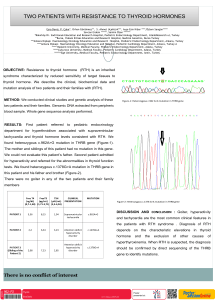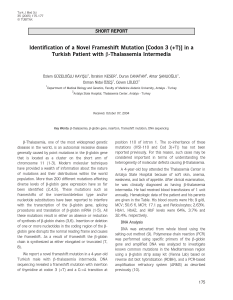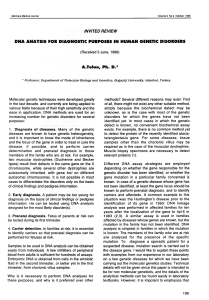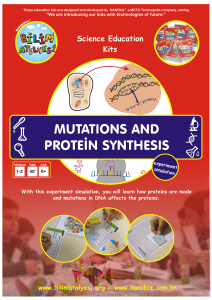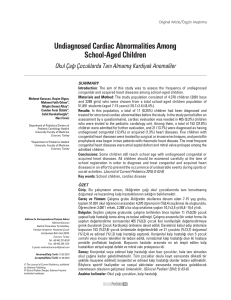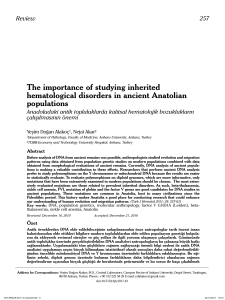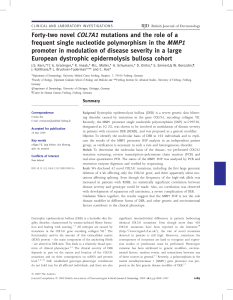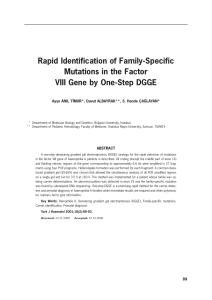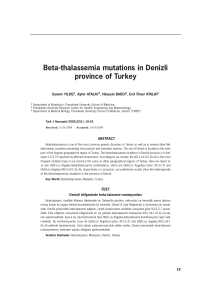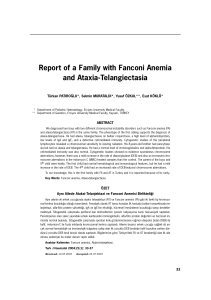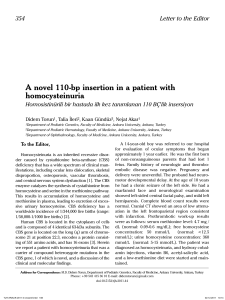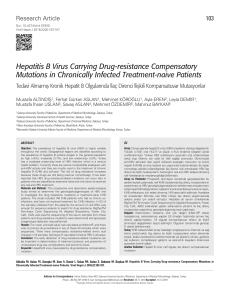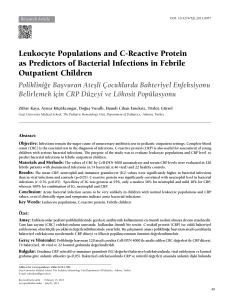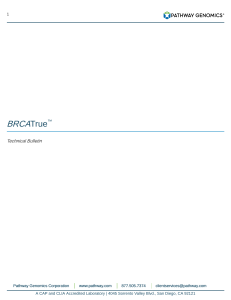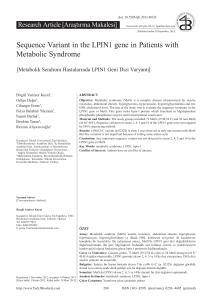The phenotype-genotype relationship in severe congenital
advertisement
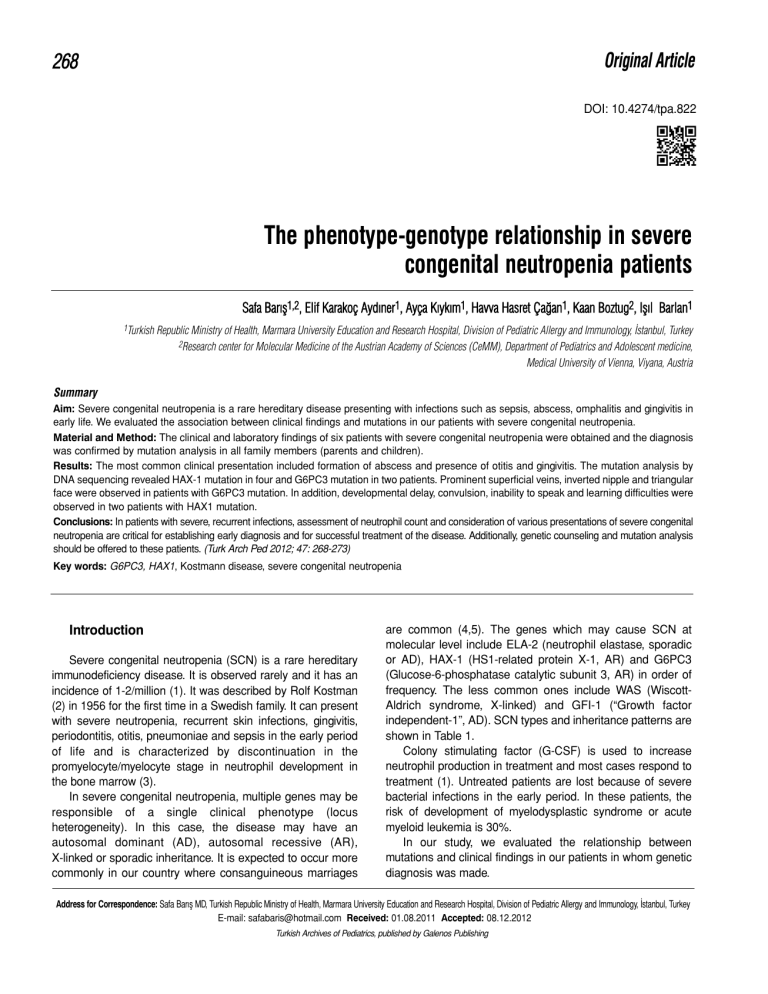
Original Article 268 DOI: 10.4274/tpa.822 The phenotype-genotype relationship in severe congenital neutropenia patients Safa Barış1,2, Elif Karakoç Aydıner1, Ayça Kıykım1, Havva Hasret Çağan1, Kaan Boztug2, Işıl Barlan1 1Turkish Republic Ministry of Health, Marmara University Education and Research Hospital, Division of Pediatric Allergy and Immunology, İstanbul, Turkey 2Research center for Molecular Medicine of the Austrian Academy of Sciences (CeMM), Department of Pediatrics and Adolescent medicine, Medical University of Vienna, Viyana, Austria Summary Aim: Severe congenital neutropenia is a rare hereditary disease presenting with infections such as sepsis, abscess, omphalitis and gingivitis in early life. We evaluated the association between clinical findings and mutations in our patients with severe congenital neutropenia. Material and Method: The clinical and laboratory findings of six patients with severe congenital neutropenia were obtained and the diagnosis was confirmed by mutation analysis in all family members (parents and children). Results: The most common clinical presentation included formation of abscess and presence of otitis and gingivitis. The mutation analysis by DNA sequencing revealed HAX-1 mutation in four and G6PC3 mutation in two patients. Prominent superficial veins, inverted nipple and triangular face were observed in patients with G6PC3 mutation. In addition, developmental delay, convulsion, inability to speak and learning difficulties were observed in two patients with HAX1 mutation. Conclusions: In patients with severe, recurrent infections, assessment of neutrophil count and consideration of various presentations of severe congenital neutropenia are critical for establishing early diagnosis and for successful treatment of the disease. Additionally, genetic counseling and mutation analysis should be offered to these patients. (Turk Arch Ped 2012; 47: 268-273) Key words: G6PC3, HAX1, Kostmann disease, severe congenital neutropenia Introduction Severe congenital neutropenia (SCN) is a rare hereditary immunodeficiency disease. It is observed rarely and it has an incidence of 1-2/million (1). It was described by Rolf Kostman (2) in 1956 for the first time in a Swedish family. It can present with severe neutropenia, recurrent skin infections, gingivitis, periodontitis, otitis, pneumoniae and sepsis in the early period of life and is characterized by discontinuation in the promyelocyte/myelocyte stage in neutrophil development in the bone marrow (3). In severe congenital neutropenia, multiple genes may be responsible of a single clinical phenotype (locus heterogeneity). In this case, the disease may have an autosomal dominant (AD), autosomal recessive (AR), X-linked or sporadic inheritance. It is expected to occur more commonly in our country where consanguineous marriages are common (4,5). The genes which may cause SCN at molecular level include ELA-2 (neutrophil elastase, sporadic or AD), HAX-1 (HS1-related protein X-1, AR) and G6PC3 (Glucose-6-phosphatase catalytic subunit 3, AR) in order of frequency. The less common ones include WAS (WiscottAldrich syndrome, X-linked) and GFI-1 (“Growth factor independent-1”, AD). SCN types and inheritance patterns are shown in Table 1. Colony stimulating factor (G-CSF) is used to increase neutrophil production in treatment and most cases respond to treatment (1). Untreated patients are lost because of severe bacterial infections in the early period. In these patients, the risk of development of myelodysplastic syndrome or acute myeloid leukemia is 30%. In our study, we evaluated the relationship between mutations and clinical findings in our patients in whom genetic diagnosis was made. Address for Correspondence: Safa Barış MD, Turkish Republic Ministry of Health, Marmara University Education and Research Hospital, Division of Pediatric Allergy and Immunology, İstanbul, Turkey E-mail: [email protected] Received: 01.08.2011 Accepted: 08.12.2012 Turkish Archives of Pediatrics, published by Galenos Publishing Barış et al. The phenotype-genotype relationship in severe congenital neutropenia patients Turk Arch Ped 2012; 47: 268-273 Material and Method Five families followed up in our clinic between 2007 and 2011 were included in our study. All subjects were being followed up as CSA and the diagnosis was made with severe bacterial infections which started in the early period and with an absolute neutrophil count below 500/mm3 in the peripheral blood. The demographic properties, consanguinity, age at the time of diagnosis, follow-up time, clinical and laboratory findings (leukocyte count, serum immunglobulin values, lymphocyte subgroups) and treatment options were recorded. After obtaining informed consent from the families DNA’s were isolated from samples of 5 ml heparinated blood obtained for mutation analysis (Promega, Madison, WI, USA). Afterwards, exon parts of the related areas were copied by PCR device using specific primers for ELA-2, HAX-1 and G6PC3 regions. The products obtained were controlled by moving in gel electrophoresis. Nucleotide sequence of the related regions were obtained using DNA sequencing device (Hitachi Applied Biosystems 3130x1 Genetic Analyser, CA, USA) and compared with the nucleotide sequence of the main gene. NM_001972,2, NM_006118,3 and NM_138387,3 were considered as the main genes for ELA-2, HAX-1 and G6PC3, respectively. Mutation analyses were done by S.B. in CeMM (Center for Molecular Medicine of the Austrian Academy of Sciences)-Vienna/Austria. 269 observed in all patients before the diagnosis. Perforated otitis and hepato-splenomegaly were found in all patients. HAX-1 mutation was found in 4 patients and G6PC3 mutation was found in two patients. Phenotypic characteristics related to different genotypes are as follows: -Neurologic involvement was observed in two of the patients with HAX-1 mutation (severe mental retardation, inability to speak and convulsion (Figure 1) in patient 3 and difficulty in learning and academic failure in patient 4). -In two patients with G6PC3 mutation, prominence in superficial skin veins (Figure 1), inverted nipple (patient 6), triangular face (patient 6), difficulty in learning (patient 5 and 6) were found. None of the two patients had urogenital anomaly related to G6PC3 mutation. Laboratory and radiologic findings The mean neutrophil count was found to be 210/mm3 (range: 100-400) before treatment and 2500/mm3 (range: 9307900) after treatment. Additionally, leukopenia was found in patient 5. No abnormality was found in hemoglobin and platalet count. Immunoglobulin values evaluated in terms of immune failure were observed to be normal or high except for patient 6 (borderline IgA deficiency). In evaluation of lymphocyte subgroups, the values were within normal limits except for low number of B lymphocytes in patient 6. Among patients who carried glucose-6-phosphate catalytic subunit 3 mutation, patient 5 had low HDL (25 mg/dL) and patient 6 had high TSH. Results Clinical findings The mean age at the time of diagnosis was found to be 45.5 months (range: 1-120 months), the mean age of onset of symptoms was found to be 5.83 months (range: 1-12 months), the delay time was found to be 38.3 months (range: 1-108 months) and the mean follow-up time was found to be 21.3 months (range: 10-37 months) in 6 patients included in the study. Demographic, clinical and laboratory findings are shown in Table 2. Consanguineous marriage and retarded growth and development were observed in all patients. Patient 1 and patient 2 were siblings. Severe bacterial infections were Figure 1. Prominence in superficial skin veins (red arrow) which may be related to G6PC3 mutation in patient 5, retardation in neuromotor development in patient 3 Table 1. Genetic defects in severe congenital neutropenia Severe neutropenia type Affected gene Characteristics ELA2 deficiency (OMIM: 202700) ELA-2 AD or sporadic transmission HAX1 deficiency (OMIM: 610738) HAX-1 AR transmission, neurologic findings G6PC3 deficiency (OMIM: 611045) G6PC3 AR transmission, prominence in superficial veins, cardiac findings and urogenital anomalies X-linked neutropenia (OMIM: 300392) WAS X-linked transmission, T cell deficiency and natural killer cell deficiency may accompany GFI-1 deficiency (OMIM: 600871) GFI1 AD transmission, B and T lymphocyte deficiency may accompany ELA2: Neutrophil elastase, HAX1: HS1-related protein X-1, G6PC3: Glucose 6 phosphatase catalytic subunit 3, WAS: Wiskott-Aldrich syndrome, GFI-1: Growth factor independent -1 2 years/M 5 years, 7 months/M 9 years, 8 months/M 8 years, 6 months/F 13 year, 4 months/M 2 3 4 5 6 + + + + + + CM Otitis, gingivits, skin abscess, pneumonia Sepsis, otitis, gingivitis, suppurative adenitis Skin abscess, otitis, pneumonia, gingivitis Sepsis, otitis, gingivitis, empyema, perianal abscess Sepsis, otitis, gingivits, perianal abscess Skin abscess, otitis, pneumonia, gingivitis Infection Prominence in superficial veins, inverted nipples, triangular face, learning difficulty Prominence in superficial veins, learning difficulty Learning difficulty Severe mental retardation, convulsion - Hepatosplenomegaly Additional findings Normal Normal Promyelocyte/ myelocyte inhibition Normal Promyelocyte/ myelocyte inhibition Promyelocyte/ myelocyte inhibition Bone marrow findings 1200/mm3 150/mm3 400/mm3 200/mm3 300/mm3 1000/mm3 2400/mm3 7900/mm3 2000/mm3 930/mm3 100/mm3 100/mm3 Neutrophil count after treatment Neutrophi count before treatment G-CSF (5 mcg/kg) G-CSF (5 mcg/kg) G-CSF (10 mcg/kg) G-CSF (5 mcg/kg) G-CSF (5 mcg/kg) G-CSF (10 mcg/kg) Treatment G6PC3 mutation (Exon 3) c.C394T p.Q132X G6PC3 mutation (Exon 6.1) c.935dupT p.Asn313fs HAX-1 mutation (Intron 4) c.556+1G>T HAX-1 mutation (Exon 3) c.431insG p.V144Gfsx HAX-1 mutation (Exon 2) c.131insA p.W44X HAX-1 mutation (Exon 2) c.131insA p.W44X Molecular disorder Nonsense mutation (not defined previously) Insertion (previously T defined) Splice mutasyon (not defined previously) Insertion G (previously defined) Insertion A (previously defined) Insertion A (previously defined) Mutation type Infections are under control with treatment Infections are under control with treatment Infections are under control with treatment Infections are under control with treatment Infections are under control with treatment Inadequate response to treatment (bone marrow transplantation has been planned) Prognosis Barış et al. The phenotype-genotype relationship in severe congenital neutropenia patients CM: Consanguineous marriage 9 years, 3 months/M Age/ Gender 1 Patient Table 2. Demographic, clinical and laboratory findings of the patients 270 Turk Arch Ped 2012; 47: 268-273 Turk Arch Ped 2012; 47: 268-273 Mitral valve failure was found on echocardiogram in patient 5. Chronic changes in the lung which may be secondary to previous pneumonia attacks (patient 1, 3, 4) and findings related to bronchiectasia (patient 5 and 6) were observed. Mutation analysis Mutation in HAX1 gene was found in four of the patients and mutation in G6PC3 gene was found in two by comparing with the main gene. Afterwards, rates of carrier state for mutations were investigated in all family members. The parents of all patients were carriers, some of the siblings were carriers and some were healthy (Figure 2). Mutations found and their effects on protein level are as follows: • Patient 1: HAX1, exon 2: insertion of nucleotide A into DNA (insertion A) causes early finish of protein synthesis by forming inhibitor codon at protein level, c.131insA-p.W44X. • Patient 2: HAX1, exon 2: insertion of nucleotide A into DNA (insertion A) causes early finish of protein synthesis by forming inhibitor codon at protein level, c.131insA-p.W44X. • Patient 3: exon 3: insertion of nucleotide G (insertion G) causes early finish of protein synthesis by forming frame-shift at protein level, c.431insG-p.V144Gfsx4. • Patient 4: HAX1, exon-intron linkage point: transformation of nucleotide G to T on DNA leads to loss of the related region at protein level, c.556+1G>T. • Patient 5: C6PC3, exon 6.1: nucleotide T insertion into DNA (insertion T) leads to abnormal protein synthesis by forming frame-shift at protein level, c.935dupT-p.Asn313fs • Patient 6: C6PC3, exon 3: transformation of nucleotide C to T on DNA (“nonsense”) ) causes early finish of protein synthesis by forming inhibitor codon at protein level, c.C394Tp.Q132X. Figure 2. Mutation analysis in HAX-1 gene exon 2 in all family members of patient 1 and 2. Formation of TAG inhibition codon by insertion of A nucleotide into the 131st region of the gene sequence at DNA level causes early finish of synthesis (X) in place of W amino acid (Triptophan) at 44th position at protein level. It is observed that the parents and two sisters are carriers (red arrow) and the other sister (blue arrow) is healthy. R: Ambiguous nucleotide (A or G), W:Triptophan, X: expresses that protein synthesis is inhibited Barış et al. The phenotype-genotype relationship in severe congenital neutropenia patients 271 Treatment G-CSF treatment was started in all patients (5-10 mcg/kg). It was observed that the number of infection attacks was decreased under treatment when the absolute neutrophil count was above 1000/mm3. Myelodysplastic syndrome or acute myeloid leukemia did not develop in any of the patients who had a mean follow-up time of 21,3 months (range: 10-37 months). Preperations for bone marrow transplantation were started in patient 1, since no sufficient response was obtained despite appropriate treatment and infections could not be controlled. Discussion Severe congenital neutropenia usually presents with a clinical picture of a severe infection including omphalitis, abscess formation, otitis, gingivitis and pneumonia in the first six months. In contrast to sinusitis, penumonia and diarrhea which are observed more commonly in other primary immune deficiencies, decreased neutrophil count in presence of findings of abscess, ulcer and gingivitis should suggest this diagnosis. Although developmental inhibition of the early stage of the granulocyte series is observed on examination of the bone marrow, patients with normal neutrophil development have been defined in recent years (6). On evaluation of our own series, normal neutrophil development was observed in three patients. In the patients examined in our study, the findings were generally found to have occurred in the first six months of life and a marked delay (mean: 38,3 months) in diagnosis was observed despite referal to a physician. In evaluation of these patients, ignorance of neutrophil count and emphasis only on leukocyte count cause a delay in diagnosis and accordingly an increase in morbidity and mortality. Again, presence of neurologic findings including convulsion and mental retardation in addition to infection and neutropenia and lack of knowledge of the possibility of a relation between these findings and neutropenia is the second factor causing delay in diagnosis. Increase in monocyte and eosinophil count may be found in addition to neutropenia on peripheral smear. Increase in immunoglobulin levels may be observed because of recurrent infection attacks (1,7). In addition, osteopenia and osteoporosis may be found in 40% of the patients. All serum immunoglobulin levels were found to be increased in three of our six patients. The other three patients had normal serum immunoglobulin levels except for one patient who had mild IgA deficiency. In severe congenital neutropenia, mutations which may explain the disease have started to be defined and it has been observed that mutations in different genes may lead to SCN due to locus heterogeneity (3,4). ELA2/ELANE, HAX-1, G6PC3, GFI1 and WASP gene mutations which may be related to SCN in order of frequency have been defined until 272 Barış et al. The phenotype-genotype relationship in severe congenital neutropenia patients now. The mutation defined firstly was ELA2/ELANE gene which is related to neutrophil elastase (8). As a result of this mutation intracellular amorphous protein accumulation was observed due to increased stress in the endoplasmic reticulum and neutrophils were observed to tend to programmed cell death in the early development stage (3). This mutation is inherited autosomal dominantly or sporadically. The other mutation defined in recent years is in HAX1 (HS1-related protein X-1) gene and its relation with SCN was found in 2007. This mutation was also found later in the family members described by Kostman et al. (9). HS1-related protein X-1 protein is located in the mitochondrium and is involved in signal transmission. The deficiency of this protein leads to disruption of the potential of the mitochondrial wall and programmed cell death (3). HS1-related protein X-1 protein is synthetized in fibroblasts and neuron cells in addition to hematopoetic cells. Therefore, in a part of the patients carrying this mutation, neurologic involvement with varying severity can be observed. This mutation should be considered, when learning difficulty, growth failure, convulsion and neutropenia are found in association. In DNA sequencing studies, neurologic involvement was not observed in mutations affecting only one isoform of HAX1 protein, whereas neurologic involvement occured in the presence of mutations affecting both isoforms (2,9). The most commonly defined mutation type in the literature is insertion A in exon 2. Most of these cases have been defined from our country where consanguineous marriages are common and they most commonly present with findings including sepsis, otitis, gingivitis, skin abscess, splenomegaly and retardation in growth and development. The findings observed were similar to the findings of our patients. On the other hand, mutations related to neurologic findings were defined in families originating from Swiss, Turkey and Japan and epilepsy and mental retardation were observed in these cases. The mutations in this group lead to dysfunction by causing early discontinuation of protein synthesis (p.Val144fs, p.Gln123fs, p.Gln190X). In our study, two of four patients who carried HAX1 mutation were neurologically normal and the mutation in these two patients were defined previously and affected only one isoform of HAX1 gene (patient 1 and 2). One of the two other patients had learning difficulty (the mutation observed was not defined previously and was determined in the fourth exon-intron linkage region-patient 4) and the other one had severe growth failure and convulsion. In this patient, the mutation was defined previously (patient 3). In recent years, G6PC3 (glucose 6 phosphatase catalytic subunit 3) mutation which has autosomal recessive inheritance and may lead to the disease has been defined in patients with SCN (10). In this group which is named as syndromic neutropenia, the most common findings include prominence in the superficial skin veins and cardiac and urogenital abnormalities. G6PC3 protein located in the glucose 6 phosphatase complex is localized in the endoplasmic reticulum and is involved in carrying glucose 6 phosphate from Turk Arch Ped 2012; 47: 268-273 the cytoplasm into the endoplasmic reticulum (3,6,10). In its deficiency, programmed cell death in neutrophils increase and therefore severe neutropenia occurs. Although developmental inhibition in the granulocyte series in the bone marrow is an expected finding in these patients, normal neutrophil development, hypoplasia, hyperplasia and dysplastic changes in the bone marrow have been observed in some patients reported (6). There are also patients in whom vacualization in myeloid cells have been observed (11). Among cutaneous findings, the most common one is prominence in the superficial veins, whereas increase in the skin elasticity and small and inverted nipples have been observed in some patients. Among cardiac abnormalities, the most common ones include atrial septal defect and patent ductus arteriosus. Pulmonary stenosis, pulmonary hypertension, hypoplastic left heart syndrome and bicuspid aorta are observed less commonly. Urogenital abnormalities defined include renal agenesis, hydronephrosis, urachal fistula, ambiguous genitalia, undescended testicles, micropenis and inguinal hernia (6, 11,12,13). In a part of these patients, frontal prominence, triangular face, malar flattening, hearing deficit, learning difficulty, scoliosis and pectus carinatus may be observed. G6PC3 mutation has been shown in patients with Dursun syndrome (13) which has been described in the literature. In these patients, pulmonary hypertension accompanies neutropenia. Dursun syndrome is considered as a subtype of SCN caused by G6PC3 (13). Thrombocytopenia, increased TSH and uric acid, decreased HDL and growth hormone deficiency have been observed in some patients in addition to neutropenia as laboratory findings (6). It has been emphasized that the risk of development of myelodysplastic syndrome and acute myeloid leukemia might be lower in these patients compared to other SCN types (14). Most of the thirty one patients defined until the present time originated from the middle-east (Turkey, Iran, Lebanon). Most mutations were found in exons. The most common ones include c,758G>A missense mutation and amino acid change at protein level (p,Arg253His). In addition, a genotype-phenotype relationship could not be established between G6PC3 mutations and different clinical findings (14,15). In our series, prominence in the superficial veins and learning difficulty were found in two patients, decreased HDL was found in patient 5, triangular face and mitral valve failure were found in patient 6, but urogenital anomaly was not found in any patient. The mutation in patient 6 was defined previously and it was observed to cause production of short protein by forming stop codon as a result of nucleotide change (p.Q132X). During clinical evaluation, presence of phenotypic properties in patients with neutropenia is important in terms of assessment of mutations. For example, neurologic problems should suggest HAX1 mutation and presence of superficial veins on the skin, cardiac and urogenital anomalies should suggest G6PC3 mutation. Because of the risk of recurrence of hereditery diseases it is important to give genetic counseling to Turk Arch Ped 2012; 47: 268-273 these patients and provide prenatal genetic diagnosis for children who will be born after determination of mutation. The less common genes which may lead to severe congenital neutropenia include WAS and GFI-1 (6). The mutation in Wiskott-Aldrich gene causes X-linked neutropenia and findings including eczema and thrombocytopenia found in classical WAS are not observed in this mutation. “Growth factor independent”-1 protein acts as a growth factor in granulocyte development and differentiation. In presence of this mutation, T-cell deficiency may accompany neutropenia (17). In treatment of the disease, the most significant target is decreasing the frequency of infections and hospitalizations. GCSF is the preferred treatment. With this treatment development and differentiation of neutrophils accelerates, cell death decreases and thus matured neutrophil count increases. The dose used is 3-5 microgram/kg as subcutaneous administration (2,4). However, treatment response shows variance and higher doses may be needed to achieve a neutrophil count above 1000/mm3 in some patients. Since there is a risk of development of myelodysplastic syndrome or acute myeloid leukemia in 20% of the patients, annual bone marrow examination and G-CSF receptor gene mutation analysis are recommended (18). Since granulocyte colony stimulating factor receptor mutation is observed in 80% of the patients in whom leukemia develops, this mutation is thought to be involved in development of malignency. In case of unresponsiveness to treatment and in patients who develop myelodysplastic syndrome or acute myeloid leukemia during the follow-up, bone marrow transplantation should be performed (3). These patients should be followed up commonly by immunology, hematology and neurology departments because of infections, hematologic changes and neurologic findings. Conclusively, SCN is a rare disease group which may cause mortality in the early period because of severe infections. In patients with mental retardation, prominence of superficial skin veins and a history of cardiac and urogenital anomalies in addition to severe infections, attention should be paid to neutrophil count. Mutation analysis and genetic counselling are important in terms of early diagnosis and treatment because of genetic transmission. Conflict of interest: None declared. References 1. Welte K, Zeidler C, Dale DC. Severe congenital neutropenia. Semin Hematol 2006; 43(3): 189-195. 2. Kostmann R. Infantile genetic agranulocytosis: a new recessive lethal disease in man. Acta Paediatr Scand 1956; 45: 1-78. Barış et al. The phenotype-genotype relationship in severe congenital neutropenia patients 273 3. Boztug K, Klein C. Genetic etiologies of severe congenital neutropenia. Curr Opin Pediatr 2011; 23(1): 21-26. 4. Boztug K, Klein C. Novel genetic etiologies of severe congenital neutropenia. Curr Opin Immunol 2009; 21: 472-480. 5. Kılıçbay F, Kılıç SŞ. Siklik nötropeni ve konjenital nötropeni (Kostmann hastalığı). Güncel Pediatri 2004; 2: 64-68. 6. Banka S, Chervinsky E, Newman WG, Crow YJ, Yeganeh S, Yacobovich J, Donnai D, Shalev S. Further delineation of the phenotype of severe congenital neutropenia type 4 due to mutations in G6PC3. Eur J Hum Genet 2011; 19: 18-22. 7. Rezaei N, Moin M, Pourpak Z, Ramyar A, Izadyar M, Chavoshzadeh Z, Sherkat R, Aghamohammadi A, Yeganeh M, Mahmoudi M, Mahjoub F, Germeshausen M, Grudzien M, Horwitz MS, Klein C, Farhoudi A. The clinical, immunohematological, and molecular study of Iranian patients with severe congenital neutropenia. J Clin Immunol 2007; 27: 525-533. 8. Dale DC, Person RE, Bolyard AA, Aprikyan AG, Bos C, Bonilla MA, Boxer LA, Kannourakis G, Zeidler C, Welte K, Benson KF, Horwitz M. Mutations in the gene encoding neutrophil elastase in congenital and cyclic neutropenia. Blood 2000; 96: 2317-2322. 9. Klein C, Grudzien M, Appaswamy G, Germeshausen M, Sandrock I, Schäffer AA, Rathinam C, Boztug K, Schwinzer B, Rezaei N, Bohn G, Melin M, Carlsson G, Fadeel B, Dahl N, Palmblad J, Henter JI, Zeidler C, Grimbacher B, Welte K. HAX1 deficiency causes autosomal recessive severe congenital neutropenia (Kostmann disease). Nat Genet 2007; 39: 86-92. 10. Boztug K, Appaswamy G, Ashikov A, Schäffer AA, Salzer U, Diestelhorst J, Germeshausen M, Brandes G, Lee-Gossler J, Noyan F, Gatzke AK, Minkov M, Greil J, Kratz C, Petropoulou T, Pellier I, BellannéChantelot C, Rezaei N, Mönkemöller K, Irani-Hakimeh N, Bakker H, Gerardy-Schahn R, Zeidler C, Grimbacher B, Welte K, Klein C. A syndrome with congenital neutropenia and mutations in G6PC3. N Engl J Med 2009; 360: 32-43. 11. Banka S, Newman WG, Ozgül RK, Dursun A. Mutations in the G6PC3 gene cause Dursun syndrome. Am J Med Genet A 2010; 152A: 26092611. 12. Arostegui JI, de Toledo JS, Pascal M, Garcia C, Yague J, Diaz de Heredia C. A novel G6PC3 homozygous 1-bp deletion as a cause of severe congenital neutropenia. Blood 2009; 114: 1718-1719. 13. Dursun A, Ozgul RK, Soydas A, Tugrul T, Gurgey A, Celiker A, Barst RJ, Knowles JA, Mahesh M, Morse JH. Familial pulmonary arterial hypertension, leucopenia, and atrial septal defect: a probable new familial syndrome with multisystem involvement. Clin Dysmorphol 2009; 18: 19-23. 14. Boztug K, Rosenberg PS, Dorda M, Banka S, Moulton T, Curtin J, Rezaei N, Corns J, Innis JW, Avci Z, Tran HC, Pellier I, Pierani P, Fruge R, Parvaneh N, Mamishi S, Mody R, Darbyshire P, Motwani J, Murray J, Buchanan GR, Newman WG, Alter BP, Boxer LA, Donadieu J, Welte K, Klein C. Extended spectrum of human glucose-6-phosphatase catalytic subunit 3 deficiency: novel genotypes and phenotypic variability in severe congenital neutropenia. J Pediatr 2011; 160: 679-683. 15. Banka S, Wynn R, Newman WG. Variability of bone marrow morphology in G6PC3 mutations: is there a genotype-phenotype correlation or agedependent relationship?. Am J Hematol 2011; 86: 235-237. 16. Klein C. Genetic defects in severe congenital neutropenia: emerging insights into life and death of human neutrophil granulocytes. Annu Rev Immunol 2011; 29: 399-413. 17. Rezaei N, Moazzami K, Aghamohammadi A, Klein C. Neutropenia and primary immunodeficiency diseases. Int Rev Immunol 2009; 28: 335-66. 18. Klein C. Congenital neutropenia. Hematology Am Soc Hematol Educ Program 2009: 344-350.
